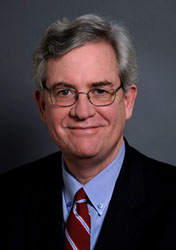More than 27 million Americans will soon gain health coverage under the health law. But who will treat them all?
With such a large coverage expansion, and with an anticipated shortage of primary care physicians available to serve them, some states have or are considering allowing so-called advanced practice nurses — those with advanced degrees — to treat more patients. David Hebert is at the issue’s center. Hebert, a veteran health care lobbyist and former CEO of the American College of Nurse Practitioners, is the first CEO of the American Association of Nurse Practitioners (AANP) — a new group with 42,000 members recently formed from the merger of the American College of Nurse Practitioners and the American Academy of Nurse Practitioners.
Hebert says that despite doubts from some doctor groups, nurse practitioners are honing their craft in patient care and research to position themselves to help care for this new influx of patients, and they’re doing so without sacrificing the quality of care.
KHN’s Alvin Tran sat down recently with Hebert to discuss the changing role nurse practitioners may soon have, as well as some physicians’ efforts to stop them.
Here are edited excerpts of that discussion:
Q. As of 2012, 18 states and the District of Columbia allow nurse practitioners to diagnose, treat patients and prescribe medications without a doctor’s involvement. What is the biggest impediment to expanding to other states? How are you planning to expand that to the other states?
Well, the problem is that there are certain states that require physicians’ supervision of nurse practitioners or there may well be some kind of restrictive collaborative agreement that is imposed upon the nurse practitioner. Often times, that makes it very difficult for nurse practitioners to practice. Sometimes there may be a physician who is unwilling to supervise. Other times you may have an issue where the physician chooses to not form a collaborative agreement with nurse practitioners. So, part of the issue is that we have anticompetitive regulations in place.
There are a number of things that we want to do at the federal level. We are hopeful that legislation is going to be reintroduced this Congress that will allow nurse practitioners in Medicare to admit patients for home health care. Right now, the admission can only be done by a physician. Given the fact that we’ve had research indicating that it would be cost effective, we can get people out of nursing homes and hospitals quicker. It really makes good public policy sense. Particularly, if you got a situation in a rural area where the nurse practitioner and the patient is waiting for the physician to sign the order to admit into home health.
Same thing is true on hospice. We’ve not been able to get legislation passed that allows nurse practitioners to admit to hospice. We’re not currently permitted by statute to form accountable care organizations on our own. That opens up a lot of possibilities for safe and effective, cost effective health care.
Q. Physicians groups, including the American Medical Association, have opposed efforts to expand the scope of practice of nurse practitioners and raised concerns of patient safety, contending that physicians’ extended training makes them more qualified to handle such issues. How do you make sure that patients are protected?
There have been studies over the years that shows that our outcomes are the same or better than primary care physicians. The fact is that it’s a total red herring. Nurse practitioners have been practicing safely and providing great outcomes for decades.
Q. Medicare’s reimbursement rate for NPs is 85 percent of the physician rate for the same services. Should these rates be the same for both providers?
One hopes that, when all is said and done, whether they’re working with a physician or billing on their own, it should be 100 percent of what a doctor is paid because the fact is, they’re providing the same services that a physician is providing. Quite frankly, it doesn’t make any sense.
Q. What role do you think NPs will have once the federal health law takes effect in 2014?
I think that once you have a full implementation of the expanded Medicaid provisions of the ACA, you’re going to see increased demand for primary care. Unless there’s someone there to provide that care, the intent of the ACA will not be fulfilled. You’re going to see a lot of patients who may be insured or have coverage under Medicare and Medicaid, but may not be able to get services.
I think the major challenges will be to look at regulations that artificially restrict a nurse practitioner’s ability to practice within their scope. If patients want to choose a nurse practitioner, they should be free to do so.
Q. Your tenure as CEO began last month, what’s at the very top of your ‘to-do list’?
We are looking at rebranding and a more enhanced public relations campaign. We’re looking at increasing membership. Right now we’re about 42,000 members and there are 155,000 nurse practitioners in this country. So, we have room for growth. We’re going to be spending some time ramping up our association activities.







